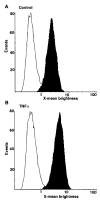The mitogenic potential of heparin-binding epidermal growth factor in the human endometrium is mediated by the epidermal growth factor receptor and is modulated by tumor necrosis factor-alpha
- PMID: 12466384
- PMCID: PMC1635788
- DOI: 10.1210/jc.2002-020069
The mitogenic potential of heparin-binding epidermal growth factor in the human endometrium is mediated by the epidermal growth factor receptor and is modulated by tumor necrosis factor-alpha
Abstract
Heparin-binding epidermal growth factor (HB-EGF), a member of the epidermal growth factor (EGF) family, is implicated in a variety of biological processes, including reproduction. Previous studies describe increased levels of HB-EGF in the human endometrium during the midsecretory stage of the menstrual cycle, suggesting a function for HB-EGF in implantation of the human blastocyst. Here we have investigated the expression and function of the soluble and transmembrane forms of HB-EGF in the human endometrium. We show that the expression of the transmembrane form of HB-EGF in the human endometrium is modulated according to the stage of the menstrual cycle. We present data demonstrating that both the soluble and transmembrane forms of HB-EGF induce DNA synthesis in human endometrial stromal cells. Furthermore, TNFalpha has a cooperative effect on HB-EGF, EGF, TGFalpha, and betacellulin-induced DNA synthesis in stromal cells, suggesting roles for the EGF family and TNFalpha in regeneration and maturation of human endometrium. Induction of DNA synthesis by HB-EGF and its modulation by TNFalpha in endometrial stromal cells are mediated by the EGF receptor and not the HB-EGF receptor ErbB4. Our data suggest key functions for HB-EGF, TNFalpha, and the EGF receptor in endometrial maturation, via autocrine/paracrine and juxtacrine pathways, in preparation for embryo implantation.
Figures







Similar articles
-
Heparin-binding epidermal growth factor and its receptors mediate decidualization and potentiate survival of human endometrial stromal cells.J Clin Endocrinol Metab. 2005 Feb;90(2):913-9. doi: 10.1210/jc.2004-0476. Epub 2004 Nov 23. J Clin Endocrinol Metab. 2005. PMID: 15562026 Free PMC article.
-
Multiple roles for heparin-binding epidermal growth factor-like growth factor are suggested by its cell-specific expression during the human endometrial cycle and early placentation.J Clin Endocrinol Metab. 1999 Sep;84(9):3355-63. doi: 10.1210/jcem.84.9.5980. J Clin Endocrinol Metab. 1999. PMID: 10487711
-
Expression of heparin-binding epidermal growth factor messenger RNA in the human endometrium.Mol Hum Reprod. 1996 Jan;2(1):31-4. doi: 10.1093/molehr/2.1.31. Mol Hum Reprod. 1996. PMID: 9238654
-
Heparin-binding EGF-like growth factor.Biochim Biophys Acta. 1997 Dec 9;1333(3):F179-99. doi: 10.1016/s0304-419x(97)00024-3. Biochim Biophys Acta. 1997. PMID: 9426203 Review.
-
Diverse functions of HBEGF during pregnancy.Mol Reprod Dev. 2009 Dec;76(12):1116-27. doi: 10.1002/mrd.21066. Mol Reprod Dev. 2009. PMID: 19565643 Free PMC article. Review.
Cited by
-
The role of angiogenic factors in fibroid pathogenesis: potential implications for future therapy.Hum Reprod Update. 2014 Mar-Apr;20(2):194-216. doi: 10.1093/humupd/dmt042. Epub 2013 Sep 29. Hum Reprod Update. 2014. PMID: 24077979 Free PMC article. Review.
-
Stromal cells from endometriotic lesions and endometrium from women with endometriosis have reduced decidualization capacity.Fertil Steril. 2006 Mar;85(3):564-72. doi: 10.1016/j.fertnstert.2005.08.046. Fertil Steril. 2006. PMID: 16500320 Free PMC article.
-
Human tumour necrosis factor: physiological and pathological roles in placenta and endometrium.Placenta. 2009 Feb;30(2):111-23. doi: 10.1016/j.placenta.2008.10.012. Epub 2008 Nov 22. Placenta. 2009. PMID: 19027157 Free PMC article. Review.
-
Effects of gonadotrophin releasing hormone analogues on human endometrial stromal cells and embryo invasion in vitro.Hum Reprod. 2009 Sep;24(9):2187-92. doi: 10.1093/humrep/dep181. Epub 2009 Jun 11. Hum Reprod. 2009. PMID: 19520710 Free PMC article.
-
Physiological and molecular determinants of embryo implantation.Mol Aspects Med. 2013 Oct;34(5):939-80. doi: 10.1016/j.mam.2012.12.011. Epub 2013 Jan 2. Mol Aspects Med. 2013. PMID: 23290997 Free PMC article. Review.
References
-
- Higashiyama S, Abraham JA, Miller J, Fiddes JC, Klagsbrun M. A heparin-binding growth factor secreted by macrophage-like cells that is related to EGF. Science. 1991;251:936–939. - PubMed
-
- Raab G, Klagsbrun M. Heparin-binding EGF-like growth factor. Biochim Biophys Acta. 1997;1333:F179–199. - PubMed
-
- Arkonac BM, Foster LC, Sibinga NE, Patterson C, Lai K, Tsai JC, Lee ME, Perrella MA, Haber E. Vascular endothelial growth factor induces heparin-binding epidermal growth factor-like growth factor in vascular endothelial cells [published erratum appears in J Biol Chem 1998 Apr 10;273(15):9352] J Biol Chem. 1998;273:4400–4405. - PubMed
-
- Abraham JA, Damm D, Bajardi A, Miller J, Klagsbrun M, Ezekowitz RA. Heparin-binding EGF-like growth factor: characterization of rat and mouse cDNA clones, protein domain conservation across species, and transcript expression in tissues. Biochem Biophys Res Commun. 1993;190:125–133. - PubMed
-
- Kennedy TG, Brown KD, Vaughan TJ. Expression of the genes for the epidermal growth factor receptor and its ligands in porcine oviduct and endometrium. Biol Reprod. 1994;50:751–756. - PubMed
Publication types
MeSH terms
Substances
Grants and funding
LinkOut - more resources
Full Text Sources
Other Literature Sources
Research Materials

